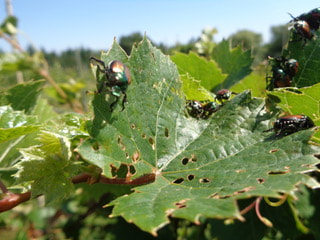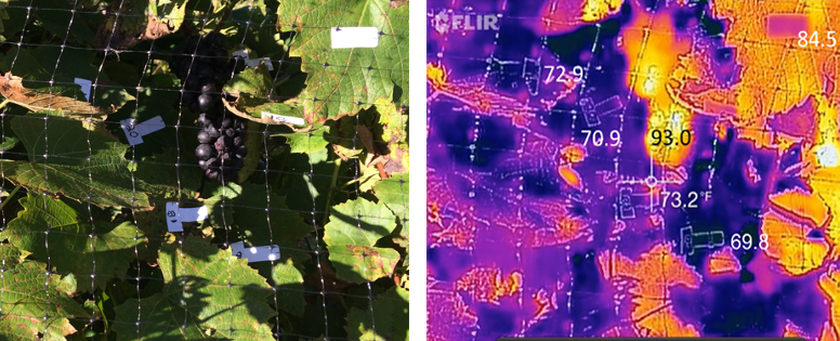|
When powerful winds strike bare, exposed soil or dry land, it can scoop up huge amounts of sand and dust into the sky, creating a sandstorm. The occurrence and size of the storm is determined by wind speed, amount of vegetation covering the soil, moisture and temperature. Northwestern and northern China all too familiar with these sandstorm events. Last weekend, on 17 February, conditions were right for generating a massive sandstorm across wide-ranging parts of Xinjiang Autonomous Region in northwestern China, from Kashgar and Turpan in the west of the province to the city of Hami in the east. Xinjiang is the largest grape and wine producing region in China, with 83,000 acres of wine grapes in cultivation, about twice the size of Napa. The majority of vineyards are located in this west to east band. Notably, all these vines are buried with half to one meter of soil in the late fall for winter protection. The soil is plowed away from the vines in the spring to uncover them. Needless to say, with all the drastic soil disruption twice a year, growing a permanent ground cover in the vineyards is not an option. These vineyards are very susceptible to wind erosion of their topsoil, especially when major sandstorms like recent one sweep through the area. One of the arguments for growing cold hardy grape varieties, which do not have to be buried, instead of vinifera types, is that it would allow a more ecological approach to vineyard soil management, with permanent, erosion resistant cover crops. Sandstorms in China are usually attributed to the destruction of vegetation, e.g. “desertification”, in the northwest provinces and in Mongolia to the north. Lack of vegetation provides the exposed soil that is picked up by the high winds to make a storm. Recent research described in the article below by the South China Morning Post attributes the size of the sandstorms like the one last weekend to the trend for more frequent occurrence of these high-powered, high speed winds. Check out this link for news coverage of the 17 February sandstorm event. news.cgtn.com/news/2024-02-19/Massive-sandstorm-engulfs-China-s-Xinjiang-1rk7HgZt0wo/p.html#:~:text=A%20severe%20sandstorm%20has%20cloaked,was%20engulfed%20in%20a%20haze. Download the pdf for the South China Morning Post article here
Today we launch an updated website -- we hope you like it and that you find it useful!
For a few years now, I have been trying to create a vineyard environment that encourages pollinator insects. I have planted wild flowers at the end of vineyard rows and allow “weeds”, like Milkweed, to grow freely in the vineyard. Also, I am trying to reduce my use of pesticides that cause collateral damage to pollinator insects. This past season I saw a host of butterflies and many different species of bees. These are photos of some of the butterflies that were attracted to the vineyard.
 One of the signatures of Vitis amurensis is its red fall color. I have a couple of amurensis vines in the vineyard and also a few amurensis hybrids that show red fall color. A beautiful sight. From a distance, their red leaves always pop out from the sea of green and yellow around them.
 Canopy gap detection. Left: Original canopy image constructed from ten images. Middle: Binary inversion to clearly isolate 'blobs' where the Kinect IR laser beam passes through the leaf canopy and does not reflect back. Right: Gaps colored to overlay the original image, showing both major (blue) and minor (orange) gaps. Measures of vine canopy density all have the goal of evaluating light penetration into the leaves and fruiting zone. Light that fosters growth and fruit maturation. Laser beams are a perfect analogue to natural light. Like natural light, some laser beams pass freely through openings along their path through the grapevine canopy, while others are blocked by leaves. I have always thought that one of Richard Smart’s most creative measures of canopy density and balance was “canopy gaps”. It is, in fact, a measure of how open the leaf canopy is to light penetration. If you look at a VSP canopy from the side, the “gaps” are the places where light can pass through from one side of the vine to the other, unimpeded by leaves or fruit. Or think of it as the spaces where you can see through the leaf canopy. If you can see through 30% of the leaf canopy, the vine gets a high score for being in balance. For years, I have eye-balled these canopy gaps in my vines. But I never had any idea how accurate my observations were. Using a MS Kinect LIDAR device (cost $149) and several image processing steps, Chuck Hisamoto and Kale Hedburg from Aster Labs LLC, and I built a system that provides almost a perfect measure of gaps in the grapevine canopy. Much more accurate than what the human eye can estimate or even what can be estimated by the tedious use of manual point quandrant methods. And it does it almost instantly. We also have conceived a method for automatically measuring the number of leaf layers in the canopy, another key measure of canopy density from Richard Smart. It uses the same low cost consumer LIDAR technology. We are looking for funding or investment to further pursue the implementation of that technology. I have always wondered about how much the temperature varies throughout the vine’s canopy, from shady areas to sunny areas. I have also wondered about how grape clusters, with their dark skins and thermal mass, accumulate heat during the day and dissipate heat at night, relative to the leaves. Thermal imaging is one way to paint a picture of temperature variations in the canopy. Thermal imagers have become consumer products. For less than $200, you can buy a FLIR One thermal imager that snaps into an iPhone and runs from an iPhone app.
The two images above give you an idea of what you can see through an infrared camera (right) compared to a visual spectrum camera (left). It's the exact same scene in both shots. The ambient air temperature is 84 degrees F. The thermal image of the grapevine canopy on the right shows a 15 degrees F temperature difference between an exterior leaf (84.5 degrees F) and a completely shaded leaf (69.8 degrees F). What does it matter? Well, photosynthesis in grapevines is optimal between temperatures of 77 degrees F and 95 degrees F. Shaded leaves fall well below that zone. With this less than optimal contribution, leaf canopy and fruit development and ripening will be less that optimal. In the northern viticulture regions, that can effect fruit and wine quality. A grape cluster is the bright object in the upper middle of the infrared scene. The cluster surface is heated up to 93 degrees F, which is 9 degrees F warmer than the air. Heat fosters the chemical reactions inside the berry that reduce malic acid. In the North, good cluster exposure to the sun is essential to reducing acidity and achieving balanced wines. One of the interesting things I noticed in my thermal pictures is that clusters that heated up during the day due to good sun exposure retained the heat and remained 5-6 degrees F above the ambient air temperature all night long. They did so even on nights when the air temperature dropped to 40 degrees F. Acidity reduction continued all night long, albeit at a much slower rate as the berries cooled off
|
Author
Tom Plocher, owner, Plocher Vines, LLC. Archives
February 2024
Categories
|
||||||||||||











 RSS Feed
RSS Feed